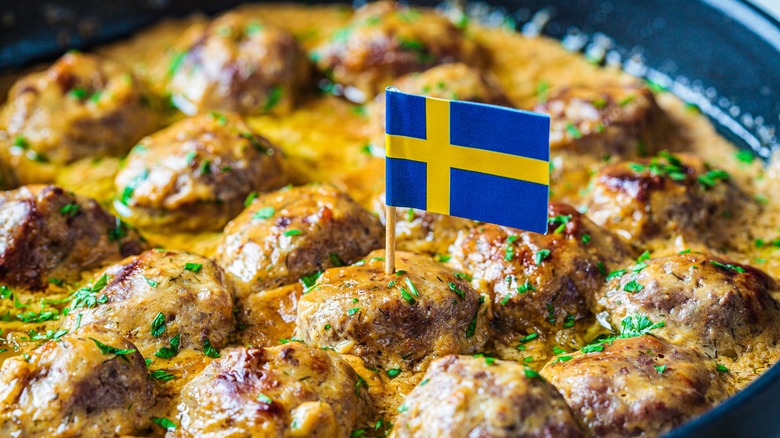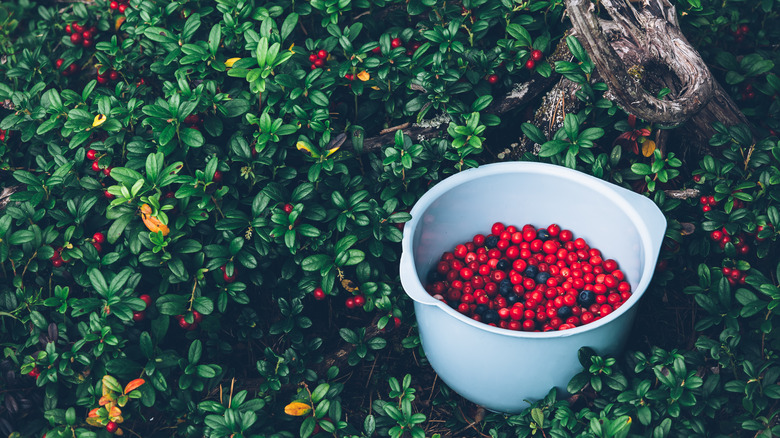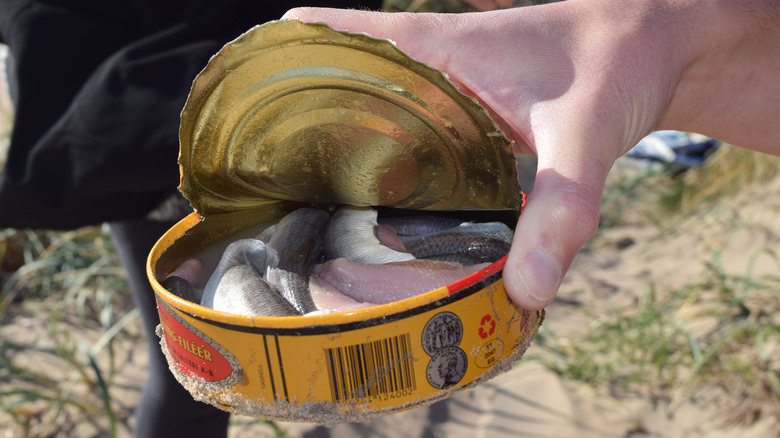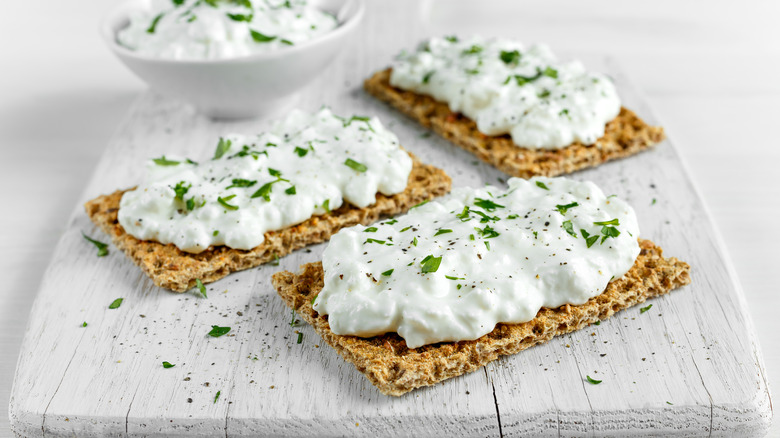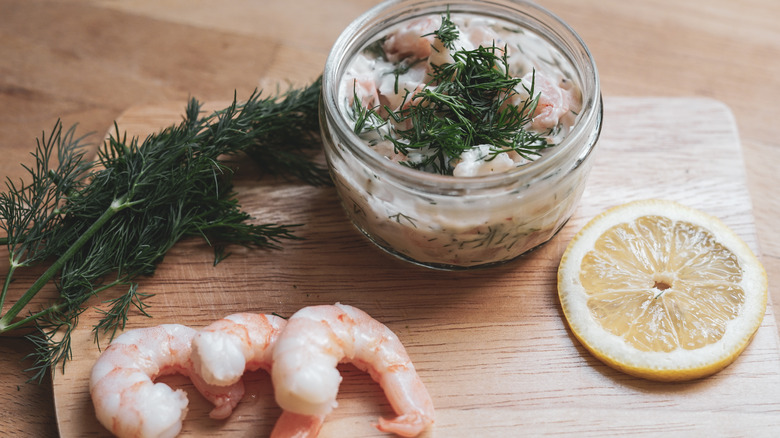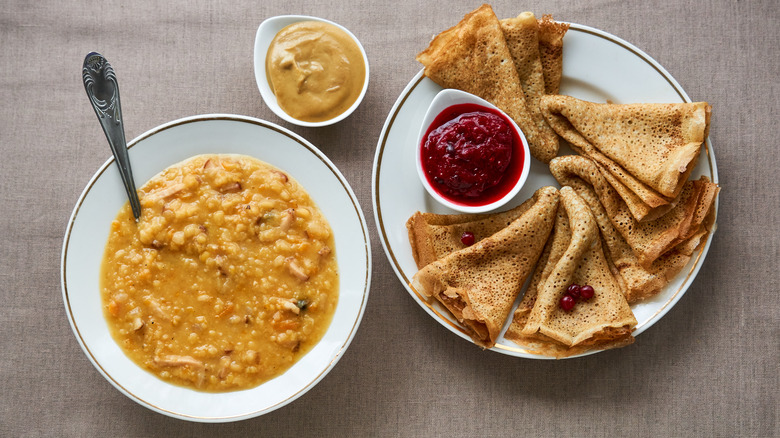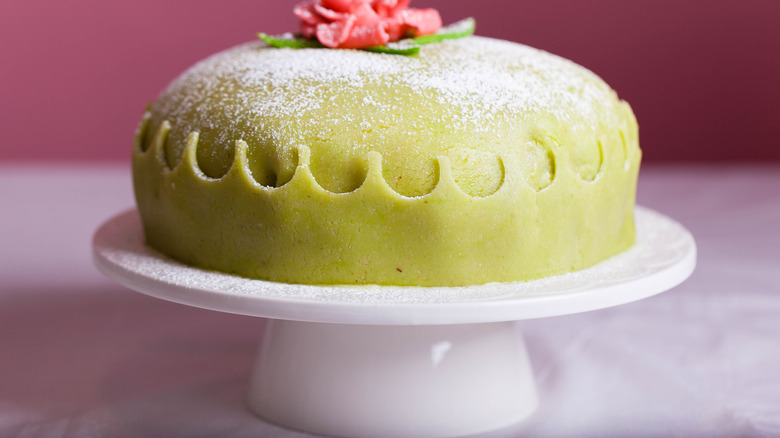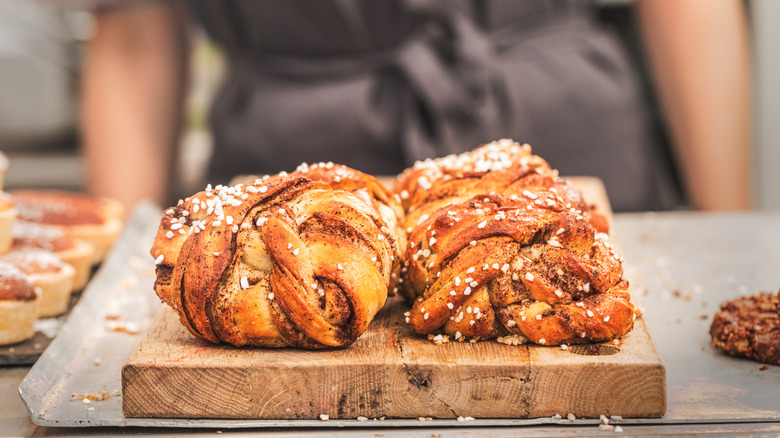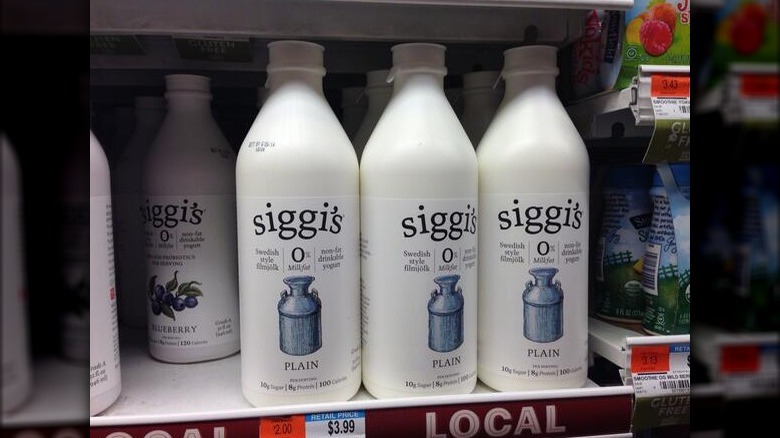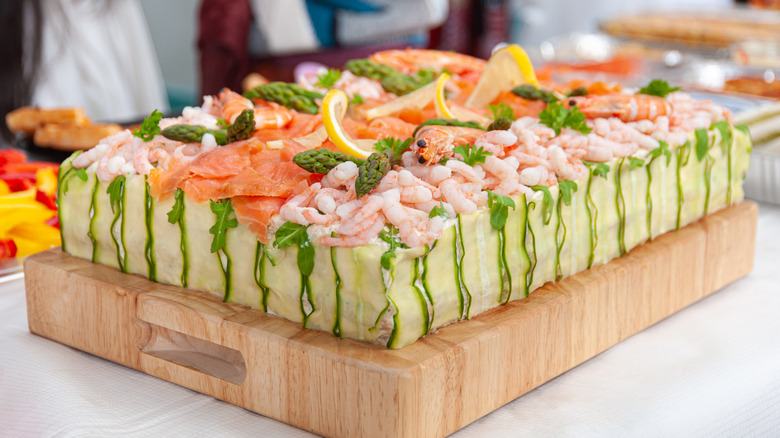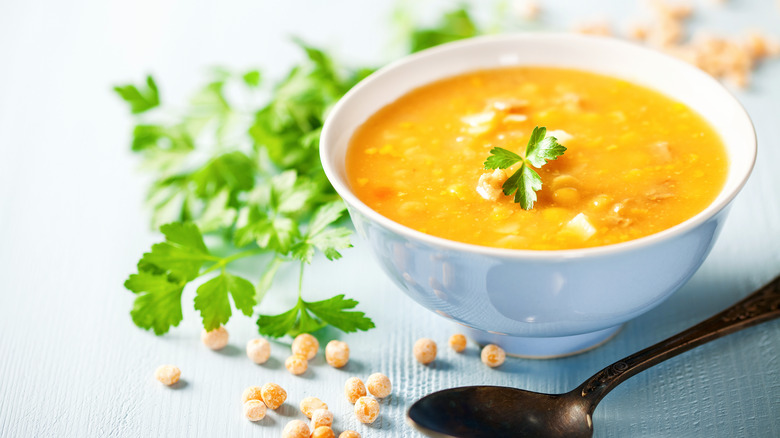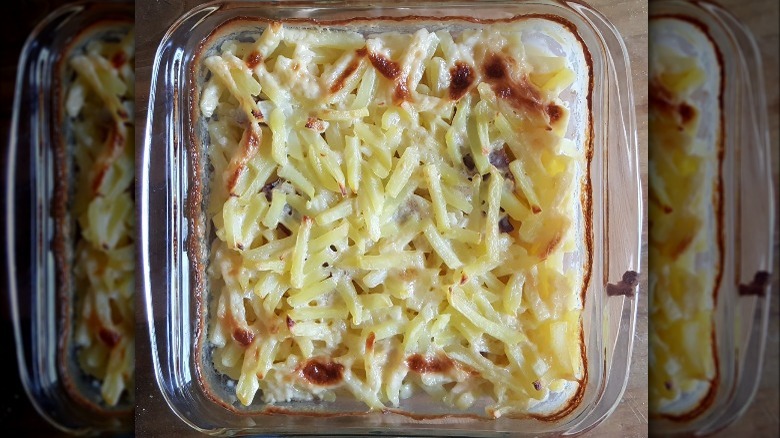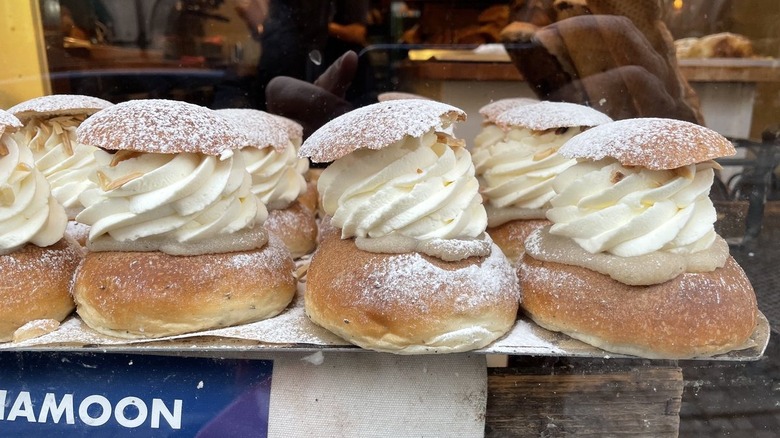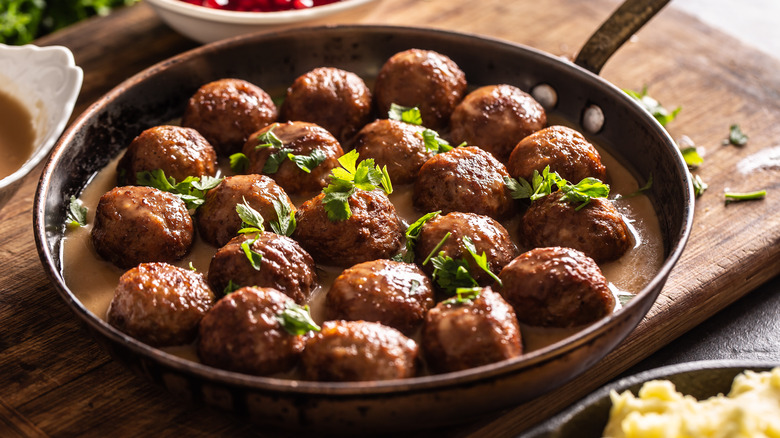13 Dishes You'll Only Find In Sweden
What's your knowledge of Swedish food? If it's limited to Swedish Fish and the meatballs you buy at IKEA, then you have a lot to learn. Sweden's culinary culture is robust and quite tasty.
As Visit Sweden notes, the country's cuisine is influenced by its history and climate. It incorporates rib-sticking staples that fueled the Vikings millennia ago, as well as comfort food, which is referred to as husmanskost. Fresh produce in Sweden centers around root vegetables, such as onions, turnips, and rutabagas, that grow easily in the country's soil. Swedish cuisine takes international influence, too, borrowing concepts and ingredients not just from neighboring countries, but also from France, Italy, Turkey, and others. The Swedes took spices and staples from world cultures and put their own unique twist on them. All of this combines to create an impressive array of foods you'll only find in Sweden — and here are some you need to try.
1. Lingonberries
Ask anyone about Swedish food and, if they have a base knowledge of the country's cuisine, they'll likely mention lingonberries. However, if you have never heard of this Scandinavian staple, the best way to think of it is that it's similar to a cranberry in that they're both small, red, and have a tart-sweet flavor.
Though they share several similarities, lingonberries and cranberries do have their differences. Cranberries are more acidic in nature, while lingonberries are slightly sweeter. Lingonberries are often used to make preserves and syrups and served with everything from pancakes to meatballs. The berries are a popular Scandinavian ingredient, but they are not as common as blueberries and cranberries, which are grown in similar climates. While lingonberries are grown in Europe, Canada, and the United States, Oregon State University reports that the growing acreage for the fruit only covers about 70 acres worldwide.
2. Sour Herring
Sour herring, or surstromming, is a particularly potent Swedish staple that Lonely Planet describes as sometimes smelling like "eggs rotting in open sewage drains." However, if you can get over the smell, you might just find that this traditional Swedish food grows on you.
Sour herring is packaged in tins (much like anchovies or other canned fish) and is most popular in northern Sweden and Lapland. A classic summertime eats, the fish is said to have come about in the 1500s when some unscrupulous Swedish sailors sold barrels of rotted herring to an unsuspecting group of Finns. However, the Finns loved them. After they pestered their Swedish neighbors for more, the sailors tried them for themselves and realized how delicious they were.
Today, the fish is made by storing fresh herring in barrels for two months before partially fermenting and then canning them. This method allows the fish to ferment for up to a year before shipping out to stores.
3. Crispbread
Crispbread has a firm place in Sweden's history with it dating back to A.D. 500, according to Leksands, a brand that has been making it for six generations. Despite the name, crispbread is more of a crispy cracker than bread. While it was traditionally made with whole grain rye, you can now find it made with multigrain, high fiber, and sesame seeds. When stored properly, the dried "bread" has a shelf life of a few years. The long shelf life is what made the food so attractive to ancient Swedes who needed convenient food during dire winter conditions.
Crispbread is eaten alongside meals or as a snack and can be topped with anything you like, such as cheese, salmon, or berries. It can be crumbled and added to yogurt or topped with pizza fixings and baked. You can buy crispbread in a variety of circular sizes, as well as triangular slices.
4. Toast Skagen
Compared to Swedish foods like crispbread and sour herring, toast Skagen, or shrimp toast, is relatively new. According to HuffPost, the food was invented in 1956 off the coast of Skagen, Denmark, by Tore Wretman, a sailor and chef known as "The Godfather of modern Swedish cuisine." When the winds died down at a regatta Wretman was attending, he decided to cook a meal for his crew in an effort to improve morale. After digging around in the boat's galley, he only came up with a few ingredients, but those ingredients were just what he needed to create the dish that would become toast Skagen. The crew loved it, morale improved, and Wretman took the dish back home to his restaurant in Sweden.
So what is this toast that Sweden has grown to love? Toast Skagen is a shrimp toast that has been spread with butter and topped with sour cream, mayonnaise, dill, and chopped shrimp. What sets it apart from other shrimp toasts is that it's served with vendace roe on top as well.
5. Pea soup and pancakes
You probably prefer to pair your pancakes with syrup or a side of bacon and eggs, but have you ever considered pairing them with pea soup? While the two foods may sound like an odd combination to some, the pairing is a favorite in Sweden.
According to Scandinavian travel guide Routes North, the traditional combo is a favorite dinner on Thursdays in particular. The pea soup is made with dried yellow peas and pork and is slow-cooked for hours. The Swedish pancakes are more akin to crepes, served thin with whipped cream and jam. The comfort food combo is said to date back to the 1400s when Catholic kitchens prepared large meals for their congregations on Thursdays to fill them up before the traditional Friday fast. Both pea soup and pancakes were relatively affordable and could be made in large batches. Today, fasting isn't requisite, but pea soup and pancakes on Thursdays are still a staple.
6. Princess cake
Princess cake is likely one of the more recognizable cakes in the world. The domed cake is covered in marzipan and has a vibrant green hue that's not typical of traditional cakes, as noted by PJP Online. The unique cake is topped with a pink flower and lightly dusted with confectioner's sugar. Inside, the cake features layers of sponge cake, jam, and a thick top layer of cream.
The Swedish classic, says The Culture Trip, was created in 1948 by Jenny Akerstrom, a cookbook author and home economics teacher who worked for Prince Carl of Sweden. At first, the recipe was named after its color, simply called "the green cake," but it was later renamed for the princesses. Both the royal connection and Akerstrom's popularity made the cake a quick hit. About 500,000 princess cakes are sold in Sweden each year and they're available in most patisseries.
7. Kanelbulle
The kanelbulle, or Swedish cinnamon bun, gets its own holiday in Sweden, on October 4, or National Cinnamon Bun Day. The Local reports that the Swedish cinnamon bun traces its roots back to the 1920s after the restrictions during World War I were lifted for sugar, eggs, and butter. While cafes and bakeries around the country began adding more of these decadent treats to their display cases, the spices used were still expensive, so most locals couldn't make the buns at home. Because of this, kanelbulle didn't become a staple in Swedish homes until the 1950s, when the spices became more affordable.
However, The Local also notes that this still isn't exactly a budget-friendly treat in the country. Statistics show that the cost of baking kanelbulle rose by 74% between 1990 and 2015, and the cost of making the kanelbulle at home rose by 52% over the same time period.
8. Filmjolk
Popular across the Nordic countries, but particularly in Sweden, filmjolk is a dairy product that's typically used in place of milk at breakfast tables. A cross between milk and yogurt, filmjolk is usually mixed with cereal or granola and can be combined with sugar, jam, fruit, and spices. While it's usually enjoyed in a meal, it can also be eaten as a snack.
Yemoos defines filmjolk as mesophilic yogurt. The fermenting process of this type of dairy takes place at room temperature rather than the high temperatures used when making traditional yogurt. This makes it easier and more convenient to make. Filmjolk is less thick and sour than yogurt, making it a little closer to milk. According to Greatist, many people who suffer from lactose intolerance find they can handle the food pretty well since the fermentation process converts a lot of the lactose to lactic acid. Filmjolk is a good source of calcium, protein, probiotics, and potassium.
9. Smorgastarta
Smorgastarta is a Swedish term that's not terribly specific. As The Local explains, it combines two words that mean sandwich (smorgas) and cake (tarta) for, quite literally, "sandwich cake." So what is a sandwich cake? A sandwich in the shape of a cake? Or a cake made out of sandwich ingredients?
The publication explains that while the dish can be interpreted in a variety of ways and include a range of ingredients it is essentially a cake made with sandwich fixings. To make a smorgastarta, one would layer slices of rye or white bread as they would cake layers, with savory fillings, such as cream cheese, mayonnaise, and pate, in between rather than sweet frosting. Additional ingredients, such as meats, veggies, cheese, and fish, are also added throughout and atop the cake. Most often, this Swedish dish is served at occasions where you'd normally have a dessert cake because it's easy to slice into pieces and can be made ahead of time and refrigerated.
10. Artsoppa
Artsoppa is another quintessential example of Sweden's husmanskost, or comfort food. Per Taste Atlas, the yellow pea soup was originally made using peas that grew fast. Artsoppa was a popular one-pot meal for the country's impoverished who typically owned only one pot. The thick stew is made using pink salt pork and onions, along with a sprinkling of marjoram, cloves, and ginger. For a lighter or vegan version, the pork is left out and the dish can be served as part of a broader meal.
This pea soup was historically popular on Thursdays as a hearty, rib-sticking meal to eat before the Catholic fast on Fridays. It also gained popularity in schools as an inexpensive meal that could be made in large quantities. Accompaniments might include pancakes (another cheap dish to make in large quantities) or bread. A glass of punsch, a Swedish alcoholic beverage, is often served alongside the stew.
11. Jansson's temptation
Jansson's temptation is a rich casserole that is made with sprats (or Swedish anchovies), potatoes or eggs, onions, heavy cream, and a binding ingredient, such as nuts or bread crumbs, as noted by The Recorder. The origin of this classic Christmas dish's name is a topic of debate. However, the most common belief is that it was named after Pelle Janzon, a Swedish opera singer with a love for food (Sweden Sverige).
Sprats are small fish that are canned in a brine of sugar and spices. The Swedish anchovies have a tender texture and "piquant flavor," per Nordic Recipe Archive. Fish casseroles made with herring and sprats became popular dishes on Swedish dinner tables during the holidays in the 1800s. While the early recipes include eggs, they were later switched out for potatoes. One trick home cooks like to do is put the potatoes in the oven to dry them out a bit before adding the wet ingredients. This makes the finished casserole light and creamy.
12. Semla
The semla is a wheat bun filled with cream and almond paste with a sprinkling of cardamom and sugar on top (per Taste Atlas). Historically, semla was only eaten on Fat Tuesday and, at the time, was simply a plain bun soaked in hot milk. The Swedes eventually added sugary ingredients and began eating it every Tuesday between Fat Tuesday and Easter.
Today, semlor — the plural form of semla — are available any time of year, though they're particularly popular in bakeries as spring approaches. A sign of Easter to come, they go out as early after Christmas as possible, much like Valentine's Day candy in the United States. Just as corporations try to put creative spins on classic foods to get a bit of buzz and new buyers, the same is happening with these buns, as manufacturers and bakers are creating new variations, such as Nutella-filled semlor, fried semlor, and even princess cake-inspired semlor.
13. Kottbullar
You can't have a list of iconic Swedish foods without mentioning Swedish meatballs. The IKEA specialty, known as kottbullar, really is a favorite in the country. However, the dish's origins aren't Swedish. Instead, as Deutsche Welle reports, the meatballs are Turkish. Swedish King Charles XII was exiled to the Ottoman Empire in the 1700s. When he returned home, he brought a Turkish recipe for meatballs with him. The official Twitter account for the country of Sweden corroborates this fact.
However, despite the admission that Swedish meatballs stemmed from Turkey, Deutsche Welle does make it clear that the relationship between today's Swedish and Turkish meatballs isn't so cut and dry. Turkish meatballs are typically made from beef or lamb, while Swedish meatballs can contain pork. Turkish meatballs are seasoned with spices, and are traditionally fried, baked, or grilled, while Swedish meatballs are usually served in a sauce. Additionally, there are nearly 300 variations of Turkish meatballs in Turkey alone, with even more meatball variations existing throughout the Middle East.
